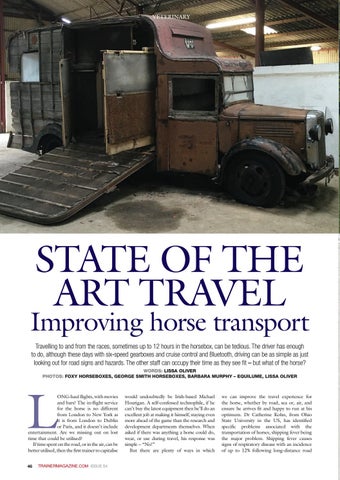VETERINARY
STATE of ThE ART TRAVEl
Improving horse transport Travelling to and from the races, sometimes up to 12 hours in the horsebox, can be tedious. The driver has enough to do, although these days with six-speed gearboxes and cruise control and Bluetooth, driving can be as simple as just looking out for road signs and hazards. The other staff can occupy their time as they see fit – but what of the horse? WORDS: LISSA OLIVER PHOTOS: FOxy HORSEbOxES, GEORGE SmITH HORSEbOxES, bARbARA muRPHy – EquILumE, LISSA OLIVER
l
oNG-haul flights, with movies and bars? The in-flight service for the horse is no different from london to New York as it is from london to Dublin or Paris, and it doesn’t include entertainment. Are we missing out on lost time that could be utilised? If time spent on the road, or in the air, can be better utilised, then the first trainer to capitalise
46
TRAINERMAGAZINE.COM ISSUE 54
would undoubtedly be Irish-based Michael hourigan. A self-confessed technophile, if he can’t buy the latest equipment then he’ll do an excellent job at making it himself, staying even more ahead of the game than the research and development departments themselves. When asked if there was anything a horse could do, wear, or use during travel, his response was simple – “No!” But there are plenty of ways in which
we can improve the travel experience for the horse, whether by road, sea or, air, and ensure he arrives fit and happy to run at his optimum. Dr Catherine Kohn, from ohio State University in the US, has identified specific problems associated with the transportation of horses, shipping fever being the major problem. Shipping fever causes signs of respiratory disease with an incidence of up to 12% following long-distance road
